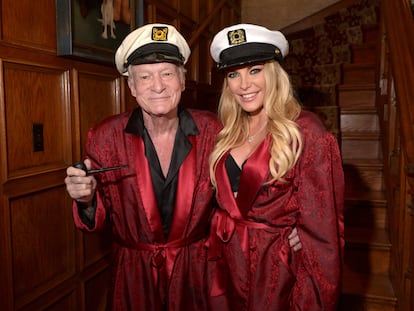Fifty years of ‘Playgirl’: Soft porn for strong women (and gay men)
In 1973, the magazine changed the rules of the game, opening a window to the female appropriation of the male gaze. ‘The penis is still something forbidden to people and to the Instagram algorithm,’ laments Daniel McKernan, author of ‘Playgirl: The Official History of a Cult Magazine’
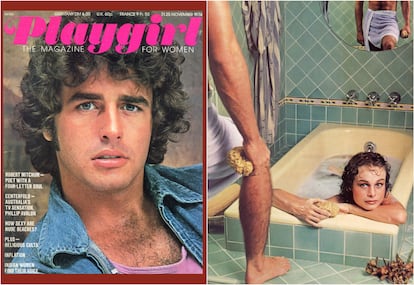

Playgirl, the first magazine to undress men for women to enjoy, had a misfire when it debuted. In the first issue, published in June 1973, there was not a single nude male portrait, not a single penis in sight. Magazine founder Douglas Lambert, a Los Angeles nightlife impresario who dreamed of a feminine, feminist Playboy for women who were “independent, self-confident, sensual, informed, involved, ambitious, sensitive, loving, generous, alive, liberated and free,” felt that female readers did not want to see everything, feel everything or experience everything.
Despite the disappointment, the first issue sold out. More than 600,000 copies were sold within four days. Readers liked the sight of a model named Eldon posing with his legs crossed and his crotch hidden in the shadow. But they wanted more and spoke out in complaint letters. “We eagerly bought our first issue of OUR magazine. We must admit that it is very well done. Many of the articles are interesting and some are quite funny. But we want to voice our unanimous complaint: we want EXPOSURE on the centerfold and in the other pictures. We accept and hope that this error will be corrected,” said the employees of Parke, Davis & Co. Laboratories, a pharmaceutical company in Michigan. “The only complaint I have is that these handsome guys pose too modestly. There is nothing obscene about a man’s naked body... Thank you, Playgirl, but please give us more,” wrote Midge Carlisle, a homemaker and mother of three.
Lambert, who aspired to become a new Hugh Hefner, listened to those women and his own wife and changed his mind. The second issue, out in July, showed actor George Maharis, star of the television series Route 66, in all his naked glory. Suddenly, Playgirl had changed the rules of the game regarding who saw and who was seen, opening a window to the female appropriation of the male gaze, to women’s heteronormative fantasies, to female sexual empowerment and, why not, to the objectification of the male body. As writer and queer icon Bruce LaBruce says, Playgirl was “a feminist corrective” to sexist magazines like Playboy, Penthouse and Hustler.
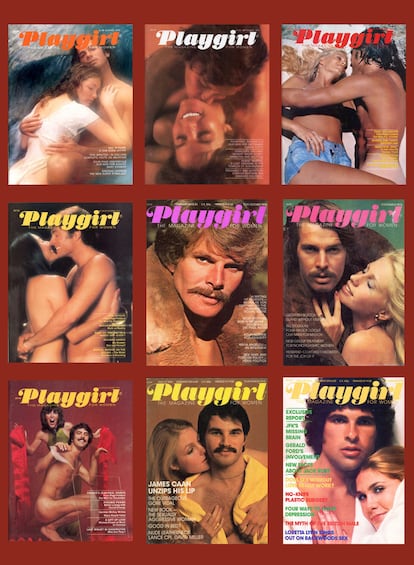
Softcore porn brought sales soaring. By 1974, Playgirl was selling more than 1.7 million copies a month in the U.S., Canada and Europe, and had a readership of 14 million. Under the motto “Entertainment for women,” it quickly became an icon of women’s liberation, but also of the gay community’s struggle. The year it was launched, 1973, was the same year that the U.S. Supreme Court legalized abortion and the American Psychiatric Association concluded that homosexuality was not a mental illness. Lambert’s magazine represented a safe place for these two groups, historically discriminated against and mistreated by heterosexual men.
Now, Playgirl is celebrating half a century of existence at a time when Trumpism is on the rise and women’s rights and those of the LGTBIQ+ community are retreating. The Supreme Court has repealed the right to abortion and states such as Florida are restricting classroom discussions about sexual orientation or gender identity. “I hope we don’t go back to the dark ages,” says Daniel McKernan, general director of Playgirl, in a telephone conversation with EL PAÍS. McKernan is also the author of Playgirl: The Official History of a Cult Magazine (Abrams Books), a 240-page book that covers the publication’s 50 years. The journalist tries to be optimistic, but recognizes that there are signs of regression. “We are having a lot of problems on social networks like Instagram. There, everything linked to Playgirl is poorly positioned. We receive many complaints and claims. On the cover of the book you can see a man’s pubic hair. Is that obscene? I don’t think so. It’s ridiculous. It’s not pornography, it’s art. The male body is still taboo. The penis is still something forbidden for people and for the Instagram algorithm. The people behind the bots that report us are human beings living in countries like India, really conservative people,” he complains.
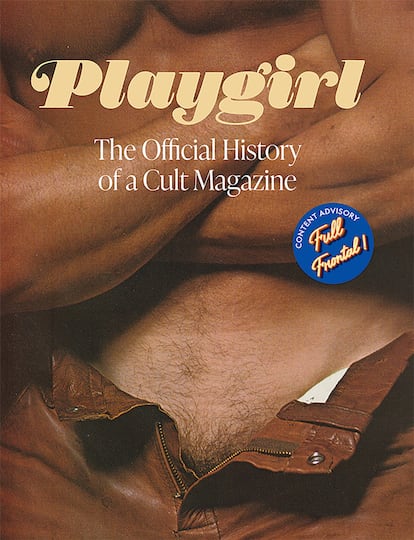
McKernan, who has worked at the magazine since 2007, came up with the idea for the book during the Covid pandemic. In the summer of 2020, at the height of the boom in remote working, she began digitizing the Playgirl archive, and by now 50% of it has already been scanned. “But it’s a huge task. It’s going to take several years to complete,” he admits. “No one knows where the original photos or negatives are. There’s no newspaper archive. Every time the magazine changed hands, everything was thrown away. We only have the old copies left,” he explains. “That’s why I think it’s important to save this legacy. It’s part of American history and pop culture.”
Playgirl has earned a place in popular culture because it has been much more than softcore porn. The pages of Playgirl: The Official History of a Cult Magazine are filled with fabulous photos, but also with hilarious and daring columns by feminist figures such as Anaïs Nin and Maya Angelou, and open discussions about sexuality and politics. It also brings to light some of the best pieces of investigative journalism, such as Anatomy of a Live Sex Show from 1974, or I Slept with a Male Prostitute from 1981, and very forward-thinking reports such as Voyeurism as Foreplay from 1980, or Both Sides of Bisexuality from 1987.

Interviews with feminist and gay icons have always been one of the magazine’s main attractions. In 1985, Grace Jones announced in Playgirl the end of sexual roles. “Do you feel that you are both a man and a woman?” she was asked. “No, that’s not a feeling. It’s a fact,” the artist replied bluntly. In 2000, Anne Rice, author of Interview with the Vampire, also spoke of the end of gender. “All my characters transcend gender. I don’t think gender is important,” she said. Singer Sandra Bernhard recalled how she lost her virginity and actress Jane Fonda spoke of her preference for monogamy, while in 1988 Cher acknowledged her weakness for younger men. “I like to play, to go out dancing and go to rock and roll concerts. “Most older men aren’t interested in that, they’re boring old men who fall asleep after a hard day at the office. I don’t want that,” she explained.

Gloria Steinem, Joyce Carol Oates, Sally Field, Joan Collins, Liza Minnelli, Goldie Hawn, Meryl Streep, Jamie Lee Curtis, Bette Midler and Joan Rivers also spoke about sex and feminism in Playgirl. In 1981, Dolly Parton admitted her own prejudices about male nudity. “I’m more embarrassed to see a picture of a naked man than to see a woman without clothes,” said the country music legend. “I think it’s natural for women to pose and want to be pretty, but I think it’s a little awkward to see a man doing sexy poses. I love men, I love skin, but I can’t take that seriously.”
In the 1980s, with Ronald Reagan’s Star Wars as a backdrop, erect penises landed in the magazine and boosted sales even further. It was the response to the stale conservatism of the time. In the 1990s, in the midst of the Sex and the City boom, the sex in Playgirl became more explicit — and gayer. McKernan is constantly asked if Playgirl is a magazine for women or for gay men. He always answers the same: “It’s a magazine for women, but gay men are always hornier.” Many of the emails he receives are from men, and many buyers of his book are men, too. “We just had an event in Palm Springs. They were all older gay men,” says the director.
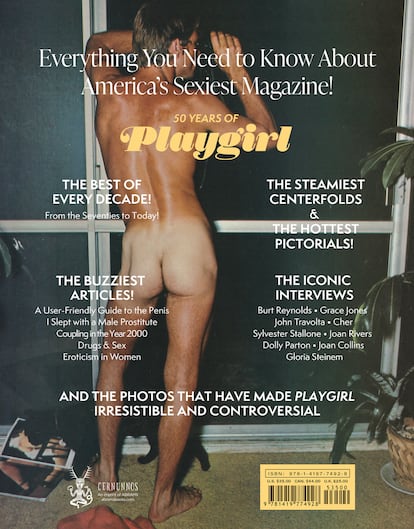
Famous men have been reluctant to show their skin in Playgirl for half a century. There were notable exceptions, such as Christopher Atkins, star of The Blue Lagoon; Tom Selleck, star of Magnum, P.I.; and Lorenzo Lamas, who played Reno Raines in Renegade. Today, movie stars and music idols still have a hard time showing themselves without clothes. “They are terrified of being associated with porn. We’re never going to have Timothée Chalamet in our magazine if we put porn actors on there. That’s why we always look for models, for the most beautiful men in the world,” explains McKernan. “All the models we work with are heterosexual. It’s like finding a needle in a haystack. Do you know how hard it is to find a good-looking guy from Nebraska who wants to show his penis?”
In the 2000s, coinciding with the rise of the internet and social media, the magazine’s sales and advertising plummeted. Playgirl changed ownership several times. In 2015, it closed and in 2020 it was relaunched by Jack Lindley Kuhns, a member of the Meyer family, owners of The Washington Post until they sold it to Jeff Bezos in 2013. The first print issue, which featured a nude and very pregnant actress Chloë Sevigny with the line “We’ll take it from here,” sold out.
They have also launched a new website, Playgirlplus.com, which offers exclusive celebrity interviews, male nudes, erotic fiction and access to the archives. A monthly subscription costs $12.95. “The feminist essence of the magazine is the same. We have new contributors and we are going back to the roots: interviews and covers with celebrities. We are working on several covers that we think will break the internet,” McKernan says.
The anniversary and the book have rekindled nostalgia for the soft-core porn of yesteryear. Collectors are paying big bucks for some of the older copies. The August 1995 issue, featuring the late Peter Steele, frontman of the gothic metal band Type O Negative, is one of the rarest to find and is for sale on eBay for $5,000.
Playgirl remains a rarity, the only magazine that has dared to appropriate the male gaze. Why aren’t there more like it? “It’s a good question. I don’t know,” answers its CEO. Are women interested in seeing naked men? “It’s another good question, but I’m not a woman,” he replies. What’s the point of Playgirl in the age of free porn and OnlyFans? “Well, it’s just that Playgirl was never about porn or just about porn. It’s always been so much more.”
Sign up for our weekly newsletter to get more English-language news coverage from EL PAÍS USA Edition
Tu suscripción se está usando en otro dispositivo
¿Quieres añadir otro usuario a tu suscripción?
Si continúas leyendo en este dispositivo, no se podrá leer en el otro.
FlechaTu suscripción se está usando en otro dispositivo y solo puedes acceder a EL PAÍS desde un dispositivo a la vez.
Si quieres compartir tu cuenta, cambia tu suscripción a la modalidad Premium, así podrás añadir otro usuario. Cada uno accederá con su propia cuenta de email, lo que os permitirá personalizar vuestra experiencia en EL PAÍS.
¿Tienes una suscripción de empresa? Accede aquí para contratar más cuentas.
En el caso de no saber quién está usando tu cuenta, te recomendamos cambiar tu contraseña aquí.
Si decides continuar compartiendo tu cuenta, este mensaje se mostrará en tu dispositivo y en el de la otra persona que está usando tu cuenta de forma indefinida, afectando a tu experiencia de lectura. Puedes consultar aquí los términos y condiciones de la suscripción digital.
